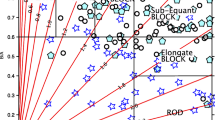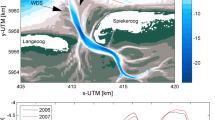Abstract
Whitings in the Bahamas have remained a sedimentological enigma for the last 80 years. Their formation has been prescribed to three major schools of thought: (a) resuspension of bottom sediment, (b) direct precipitation from bank water, and (c) biological mediation. This paper reports on field evidence to support the formation of two classes of whitings. The first class of whitings are those that have been reported in the literature extensively for the past 80 years. These whitings occur in deeper bank water (5–15 m) and are formed through the tidal oscillations of bank water through sediment-filled blue holes. The fish suspension model, hypothesized but not demonstrated for whiting occurrences out on the open banks, may apply to near-shore whiting events. Sediment-filled blue hole distributions have also been calculated for the Bahamian platforms and there should be more than 2,500 sediment-filled blue holes on Great and Little Bahama Banks. This large number of sediment-filled blue holes on the Bahamian banks more than adequately accounts for the density of whitings and explains their point source nature and occurrence at the same locations through time.







Similar content being viewed by others
References
Beach DK (1995) Controls and effects on subaerial exposure on cementation and development of secondary porosity in the subsurface of Great Bahama Bank. In: Budd DA, Salle AH, Harris PM (eds) Unconformites and Porosity in Carbonate Strata. American Association of Petroleum Geologists, Tulsa, pp 1–33
Black M (1933) The precipitation of calcium carbonate on the Great Bahama Bank. Geol Mag 70:455–466
Boss SK, Neumann AC (1993) Physical versus chemical processes of “whiting” formation in the Bahamas. Carbonates Evaporites 8:135–148
Broecker WS, Takahshi T (1966) Calcium carbonate precipitation on the Bahama Banks. J Geophys Res 71:1575–1602
Broecker WS, Sunyal A, Takahshi T (2000) The origin of Bahamian whitings revisited. Geophys Res Lett 27:3759–3760
Bustos-Serrano H, Morse JW, Millero FJ (2009) The formation of whitings on the Little Bahama Bank. Mar Chem 113:1–8
Carew JL, Mylroie JE (1995) Quaternary tectonic stability of the Bahamian archipelago: evidence from fossil coral reefs and flank margin caves. Quat Sci Rev 14:145–153
Carroll JJ, Slupsky JD, Mather AE (1991) The solubility of carbon dioxide in water at low pressures. J Phys Chem Ref Data 20:1201–1209
Cloud PE (1962) Environment of calcium carbonate deposition west of Andros Island Bahamas. US Government Printing Office, Washington, DC
Cunliffe S (1985) The flora and fauna of Sagittarius, an anchialine cave and lake in Grand Bahama. Cave Sci 12:103–109
Debenay J-P, André J-P, Lesourd M (1999) Production of lime mud by breakdown of foraminiferal tests. Mar Geol 157:159–170
Dierssen HM, Zimmerman RC, Burdige DJ (2009) Optics and remote sensing of Bahamian carbonate sediment whitings and potential relationship to wind-driven Langmuir circulation. Biogeosciences 6:1–14
Dill RF (1977) The blue holes—Geologically significant submerged sink holes and caves off British Honduras and Andros, Bahama Islands. In: Proceedings, Third International Coral Reef Symposium, May 1977, pp 237–242
Ellis JP, Milliman JD (1985) Calcium carbonate suspended in Arabian Gulf and Red Sea waters: biogenic and detrital, not “chemogenic”. J Sediment Petrol 55:805–808
Glenn CR, Rajan S, McMurtry GM, Benaman J (1995) Geochemisty, mineralogy, and stable isotopic results from Ala Wai estuarine sediments: records of hypereutrophication and abiotic whitings. Pac Sci 49:367–399
Hine AC, Steinmetz JC (1984) Cay Sal Bank, Bahamas—A partially drowned carbonate platform. Mar Geol 59:135–164
Hoskin CM, Reed JK, Mook DH (1986) Production and off-bank transport of carbonate sediment. Black Rock, southwest Little Bahama Bank, Mar Geol 73:125–144
Larson EB, Mylroie JE (2012a) Infilled blue holes on the Bahama banks as point sources for whiting origin. Geol Soc Am Abstracts with Programs 44:25
Larson EB, Mylroie JE (2012b) Modeling blue hole development in the Bahamas. Geol Soc Am Abstracts with Programs 44:170
Macintyre IG, Reid RP (1992) Comment on the origin of aragonite needle mud: a picture is worth a thousand words. J Sediment Petrol 62:1095–1097
Martin JB, Gulley J, Spellman P (2012) Tidal pumping of water between Bahamian blue holes, aquifers, and the ocean. J Hydrol 416–417:28–38
Milliman JD, Freile D, Steinen RP, Wilber RJ (1993) Great Bahama bank aragonitic muds: mostly inorganically precipitated, mostly exported. J Sediment Petrol 63:589–595
Morse JW, Millero FJ, Thurmond V, Brown E, Ostlund HG (1984) The carbonate chemistry of Grand Bahama Bank waters: after 18 years another look. J Geophys Res 89:3604–3614
Morse JW, Gledhill DK, Millero FJ (2003) CaCO3 precipitation kinetics in waters form the Great Bahama Bank: implications for the relationship between bank hydrochemistry and whitings. Geochim Cosochim Acta 67:2819–2826
Morse JW, Andersson AJ, Mackenzie FT (2006) Initial responses of carbonate-rich shelf sediments to rising atmospheric pCO2 and “ocean acidification”: role of high Mg-calcites. Geochim Cosochim Acta 70:5814–5830
Mylroie JE, Mylroie JR (2011) Void development on carbonate coasts: creation of anchialine habitats. Hydrobiologia 677:15–32
Mylroie JE, Mylroie JR (2013) Pseudokarst caves in the littoral environment. In: Lace MJ, Mylroie JE (eds) Coastal Karst Landforms. Springer, Dordrecht, pp 3–14
Mylroie JE, Carew JL, Moore AI (1995) Blue holes: definition and genesis. Carbonates Evaporites 10:225–233
Palmer RJ, Heath LM (1985) The effect of anchialine factors and fracture control on cave development below eastern Grand Bahama. Cave Sci 12:93–97
Palmer RJ, Warner GF, Chapman P, Trott RJ (1998) Habitat zonation in Bahamian blue holes. Cave and Karst Sci 25:93–96
Reijmer JJG, Swart PK, Bauch T, Otto R, Reuning L, Roth S, Zechel S (2009) A re-evaluation of facies on Great Bahama Bank I: new facies maps of western Great Bahama Bank. In: Swart PK, Eberli GP, McKenzie JA (eds) Perspectives in carbonate geology: a tribute to the career of Robert Nathan Ginsburg. Wiley-Blackwell, West Sussex, pp 29–46
Robbins LL, Blackwelder PL (1992) Biochemical and ultastructural evidence for the origin of whitings: a biologically induced calcium carbonate precipitation mechanism. Geology 20:464–468
Robbins LL, Tao Y, Evans CA (1997) Temporal and spatial distribution of whitings on Great Bahama Bank and a new lime mud budget. Geology 25:947–950
Roth S, Reijmer JJG (2005) Holocene millennial and centennial carbonate cyclicity recorded in slope sediments of the Great Bahama Bank and its climatic implications. Sedimentology 52:161–181
Shinn E (1985) Mystery muds of Great Bahama Banks. Sea Front 31:337–346
Shinn EA, Steinen RP, Lidz BH, Swart PK (1989) Whitings, a sedimentological dilemma. J Sediment Petrol 59:147–161
Shinn EA, Marot M, Holmes CW (2004) Solving the whiting problem with short-lived isotopes, still no fish. In: American Association of Petroleum Geologists Annual Meeting, Dallas, April 18–21, 2004. Proceedings of the American Association of Petroleum Geologists Bulletin, vol 88, no 13
Stieglitz RD (1973) Carbonate needles: additional organic sources. Geol Soc Am Bull 84:927–930
Thompson JB (2000) Microbial whitings. In: Riding RE, Awramik SM (eds) Microbial sediments. Springer, Berlin, pp 250–260
Thompson JB, Schultze-Lam S, Beveridge TJ, Des Marais DJ (1997) Whiting events: biogenic origin due to the photosynthetic activity of cyanobacterial picoplankton. Limnol Oceanogr 42:133–141
Trott RJ, Warner GF (1986) The biota in the marine blue holes of Andros Island. Cave Sci 13:13–19
Vacher HL (1988) Dupuit-Ghyben-Herzberg analysis of strip-island lenses. Geol Soc Am Bull 100:580–591
Vacher HL, Mylroie JE (2002) Eogenetic karst from the perspective of an equivalent porous medium. Carbonates Evaporites 17:182–196
Warner GF, Moore CAM (1984) Ecological studies in the marine blue holes of Andros Island, Bahamas. Cave Sci 11:30–44
Wells AJ, Illing LV (1964) Present-day precipitation of calcium carbonate in the Persian Gulf. In: van Straaten LMJU (ed) Deltaic and shallow marine sediments. Elsevier, Amsterdam, pp 429–435
Whitaker FF (1988) The blue holes of the Bahamas: an overview and introduction to the Andros project. Cave and Karst Sci 25:53–56
Whitaker FF, Smart PL (1997) Hydrogeology of the Bahamian archipelago. In: Vacher HL, Quinn T (eds) Geology and Hydrogeology of Carbonate Islands. Elsevier, Amsterdam, pp 183–216
Yates KK, Robbins LL (1998) Production of carbonate sediments by unicellular green alga. Am Miner 83:1503–1509
Acknowledgments
Nancy Albury, Brian Kakuk and Tom Iliffe are thanked for access to their blue hole databases. Michael and Nancy Albury and Nicole Ridlen are also thanked for their help with field work. The Department of Geosciences at Mississippi State University and Exxon-Mobil provided financial support to the authors.
Author information
Authors and Affiliations
Corresponding author
Rights and permissions
About this article
Cite this article
Larson, E.B., Mylroie, J.E. A review of whiting formation in the Bahamas and new models. Carbonates Evaporites 29, 337–347 (2014). https://doi.org/10.1007/s13146-014-0212-7
Accepted:
Published:
Issue Date:
DOI: https://doi.org/10.1007/s13146-014-0212-7




